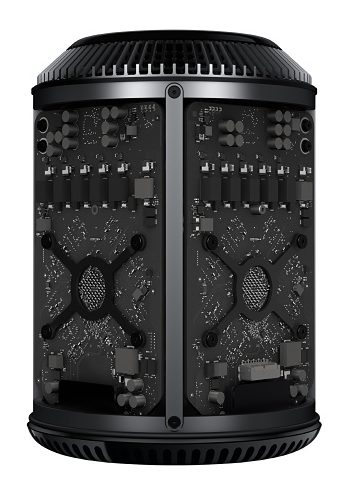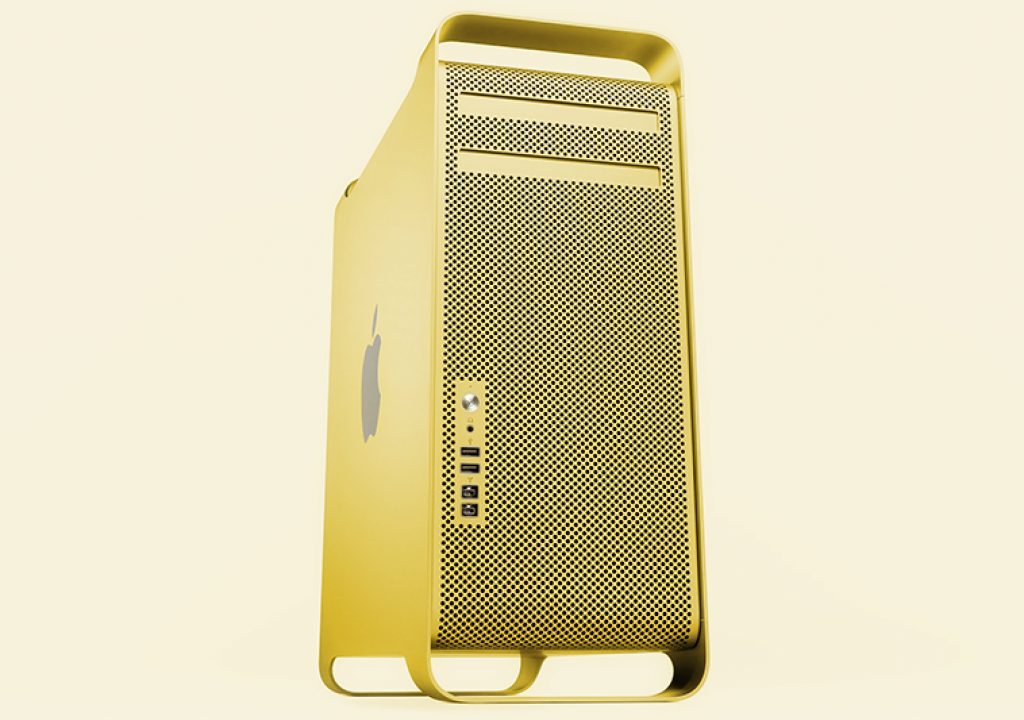
For all their sex appeal, the trashcan Mac Pros are crazy expensive when fully loaded, expandable only via Thunderbolt breakout chassis (add more crazy expensive here), and start to lose their sex appeal once the rat’s nest of cables begins snaking its way out of the back of the thing to create a functional working platform. Oh, and they haven’t been upgraded since their release three years ago–a small eternity in the modern tech era.
In contrast, the older Mac Pros of 2012 have oodles of PCIe slots, accessible RAM upgradeable to 128GB, and with as many as 12 cores worth of 3.06GHz Westmere Xeon processing these machines still pack a healthy punch. As I’ve said in previous articles, these days it’s all about the GPU and those 2012 machines can still accommodate the latest cards by either Nvidia or AMD.
Alas, the mainstream emergence of Thunderbolt is finally revealing the wrinkles on those aging towers. The blinding speed of Thunderbolt 3 combined with the proliferation of Thunderbolt drives are a double blow.
With so many people using those little orange LaCie drives for their media it’s hard to play in a universe that lacks Thunderbolt connectivity. But hang on, those drives also have a USB 3.0 connection. That’s just as fast for what a portable drive puts out, isn’t it? Oh, that’s right: Apple’s 2012 Mac Pro only shipped with USB 2.0 ports, even though USB 3 devices started hitting the market in 2010. (As an aside, you can purchase PCI expansion cards to add USB 3.0 to your Mac Pro tower.)
The Mac Pro of the future
refers to an actual product or a skunkworks project deep within the bowels of Cupertino.
It’s completely possible that Apple will choose not to renew the Mac Pro at all. Instead, like the ill-fated iPod Hi-Fi it might quietly fade away in awkward silence. After all, Apple of 2016 is a consumer electronics company and the Mac Pro’s tiny market is a blip on the profitability radar.
Another scenario is that Apple will persist with the existing model. Apple is great at many things, but it doesn’t always fess up to it’s missteps. A return to a big box with lots of expansion slots says, “That whole compact trashcan thing? Yeah, we didn’t really think through the use cases.”
Would an update of the current Mac Pro be a bad thing? Maybe not. 2017 is a better place to live if you’re counting on expansion via Thunderbolt. With sustained Thunderbolt 3 RAID speeds climbing well beyond 2,000 MBps (that’s bytes not bits) and companies like Razer releasing hot-swappable PCIe Thunderbolt expansion units in the sub-$500 range, it’s conceivable that a modern Mac Pro could be efficiently outfitted for high-end post-production work.
Moving past denial: your Mac Pro replacement system
There have been rumors that Apple will release a new Mac Pro before the end of November, 2016. It seems a little strange that they would have missed the opportunity to announce at the October event, but it’s not completely unprecedented.
But let’s assume we arrive at December 1st with nary a word from Cupertino. Once you’ve decided you can no longer wait for a refresh of the Mac Pro, what are your options?
Build a Hackintosh
Hackintoshes were all the rage for a while there. The idea is this: buy a bunch of PC hardware that’s really similar to Mac hardware and use a tweaked driver set to get everything purring like a real Mac (since modern Macs run under the same architecture and tend to use third party components like networking chips that are available as standalone PCIe cards).
The upside is you can actually end up with a higher-performance machine than the current Mac releases, and expand the system to your heart’s content.
The downside? In addition to the dubious legalities (has anyone bothered to read the OS X EULA? I’m sure there’s plenty of, “Thou shalt not run this on a Hackintosh” language in there), a minor OS update can wreak havoc with all those custom drivers. I’ve noticed a pattern with Hackintosh experimenters: For the first few weeks after successfully getting a Hackintosh up and running, the Hackintosher is a gushing evangelist. Come back to them a month or two later and they’ll sheepishly admit that they’re back to using it as a Windows machine. Why? An unexpected software update got ‘em.
Here’s the end reality: apart from the experience of being in the OS, the apps behave the same on either platform. So why deal with the pain of trying to keep homeostasis on a machine pretending to be a Mac when you could quite happily be running the same software under Windows? After all, Windows 10 doesn’t suck.
My advice: Leave the kexting (not a typo) to the teenage geeks and computer science majors still living with their parents. Leave your Windows machine a Windows machine and your Mac a Mac. Anything else is just unnatural.
Buy an iMac
OK, so Apple may not be updating the Mac Pro–at least not often–but the iMac gets plenty of love. It fits the image of Apple as a consumer electronics company and as such undoubtedly has a rosy future ahead of it. Could it be your next edit bay solution?
At the end of the day the CPU and bus architecture is probably going to be the biggest bottleneck to performance. After all, what we’re really looking at here is a really big laptop on a stand. The iMac is built for heat management in a compact form factor and that has to end in some performance compromises.
Expandability? Yes–via the two Thunderbolt 2 slots. There’s enough bandwidth there to get good performance from outboard GPU’s, albeit not quite as efficiently nor affordably as Thunderbolt 3 (which will doubtless make its way into the next iMac refresh).
And then there’s the IPS 5K display with enough color accuracy to be useful as a color grading monitor for broadcast projects (although I’m not a professional colorist nor color scientist, so those of you who are feel free to disabuse me in the comments).
In summary, the iMac actually presents as a viable mid-range edit, grading and effects station. It’s not going to be your choice for multiple streams of RAW 4K, but it could be a very solid option for ProRes, DNxHD and DNxHR workflows.
Linux
So you just can’t stand Windows, but you don’t feel like the Mac hardware gives you what you need. How about Linux? After all, it’s a close cousin to the UNIX base architecture of OS X. Could it
If you’re editing in DaVinci Resolve or Lightworks, maybe. For Avid or Premiere there isn’t a Linux version so you’re out of luck.
More importantly though, if you love the Mac it’s probably because of it’s user-friendly UI design. Despite what your developer and IT friends will try to tell you, Linux is still geek territory. Yes it comes with a variety of nice-looking GUI makeovers, but at the end of the day to get all your hardware talking nicely to your software you’ll find yourself grepping away in a terminal at some point. That’s great if you’re a sys admin, not so helpful if you’re a creative who just wants to sit down and edit.
The closest compromise: Windows + Macbook
I want to be clear up front: I love working on a Mac. Even with multiple Macs and PCs in my studio I still find myself gravitating to working on a Mac if I have no performance need to be elsewhere.
Likewise if you plan on editing in Final Cut Pro you’re only option is Mac. But for everything else there’s Windows. And with Thunderbolt finally arriving on the Windows platform in full force (the initial driver hiccups seem to have cleared up) there’s no real performance differentiator between the two platforms.
Now if like me you prefer a Mac because you just enjoy the experience of working in the Finder and using Apple Mail, may I propose the following: get yourself an updated MacBook for all the stuff you love in a Mac and buy a Windows workstation as your primary editing platform. Once you’ve launched Media Composer/Resolve/Premiere Pro/After Effects/<insert name of your favorite app here> the experience is essentially the same on either platform. Even if you’re jumping between apps you’ll only have to look at the Windows desktop for a few seconds in between. If it offends you that much, have an intern launch it while you get coffee.
Buy a Mac Pro
This is the hardest option to recommend, simply because right now you’re paying a premium for 2013’s technology, with no ability to upgrade components later. Of course you can always sit and wait for the miracle of the hardware refresh. The beauty of waiting in the tech industry is that things are only going to get better and/or cheaper while you wait.
Up next…
In a follow up article we’ll take a look at configuring a high-performing workstation and look at the pros and cons of heavy customization in the PC world.
Damian Allen is a VFX supervisor and pipeline consultant based in LA. He specializes in stereoscopic and picture-lock emergency effects work through his company Pixerati LLC. In addition to his hands-on production work, Damian lectures and trains artists around the world in compositing theory and technique.

